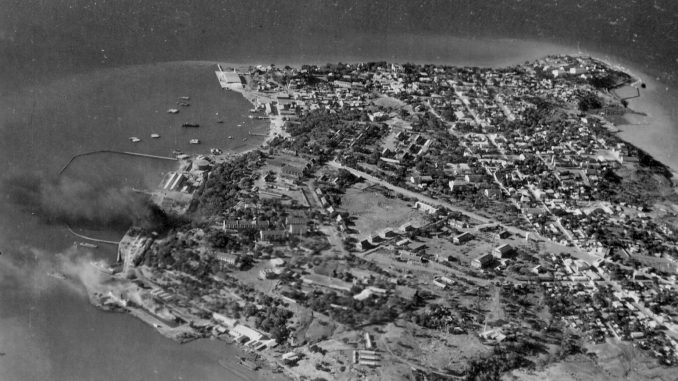
Plans to take the Vichy French island of Madagascar, codenamed Operation Ironclad, had been laid even before the Japanese fleet made their incursion into the Indian Ocean in April 1942. The fear was that the island could be used as a staging point for Axis forces, such as German or Japanese submarines or surface raiders, to operate in the Ocean. This would threaten the vital supply routes from Europe to the Far East via the Suez Canal or the Cape of Good Hope. Initial plans called for the capture of the port of Diego Suarez, on the northern tip of Madagascar, with the rest of the island to be conquered gradually thereafter. Diego Suarez had one of the finest natural harbours in the world, and the city was easily defensible from the sea and the land. A single airfield at Arrachart served the north of the island.
French forces on the island were relatively small. After the fall of France the Vichy government had aligned with Nazi Germany, although in military terms it was mostly equipped with equipment that had survived the fall of France. Ground troops on Madagascar consisted mainly of colonial troops – Senegalese and Malagaches for the most part, led by French officers but lacking heavy equipment such as artillery and armoured vehicles. The Vichy Air Force contingent was likewise small, with about 20 reasonably modern MS.406 fighters, some Potez 63.11 reconnaissance craft, and a few ancient Potez 25 biplanes.
The British assembled two army brigades and a Royal Marines commando unit for Operation Ironclad, carried aboard several transports. These troops were backed up by the Eastern Fleet’s Force F, under the command of Vice Admiral Edward Syfret, centred on the carriers Illustrious and Indomitable, the old battleship Ramillies, a cruiser and 8 destroyers. Aboard the carriers were five squadrons of fighters: Martlets (Lend-Lease F4F Wildcats), Fulmars, and Sea Hurricanes. There were also two squadrons of Albacores, and two of Swordfish. Waiting in Africa for an airfield to be captured was 16 Squadron, South African Air Force, with Maryland and Beaufort bombers.
Operation Ironclad
The invasion fleet assembled at Durban, South Africa, with many of the ships sailing all the way from Britain to join Syfret’s force. The ships departed Durban on the 25th of April, heading north for Madagascar. It was hoped that after the capture of Diego Garcia the French governor of the island would agree to an armistice, but this would prove to be an overly optimistic estimate of the situation. The ships moved into position during the night to land troops at dawn on the 5th of May. The French were caught completely by surprise by Operation Ironclad and the landings on five beaches in and around Courier Bay on the western coast of Madagascar were unopposed. The British then began to advance on the towns of Diego Garcia and Antsirane.
Both Illustrious and Indomitable launched aircraft to support the invasion. Fighters patrolled over the beachhead whilst the Albacores and Swordfish moved in to support the advancing troops. The Swordfish attacked French vessels in the harbour in several waves of six. The first wave attacked sloop D’Entrecasteaux initially, but did not cause significant damage. They then turned their attention to the armed merchant cruiser Bougainville, dropping several torpedoes which streaked towards the immobile ship. She was hit by a torpedo, blew up, and sank. A second wave of Swordfish was armed with depth charges, and they used these to sink the submarine Beveziers. The third wave dropped leaflets advising the French to surrender, and then attack the D’Entrecasteaux. The sloop again escaped major damage and was eventually able to leave the harbour. She attempted to make her way around the northern coast of Madagascar to attack the mass of British shipping supporting the landings, but the following day she was again attacked again by Swordfish which bombed and heavily damaged her. She was then beached to prevent her loss.
Albacores from Indomitable meanwhile attacked Arrachart airfield. They achieved complete surprise, with all of the French aircraft at the field still on the ground. Five MS.406 fighters were destroyed and several other aircraft damaged, which secured the air over the north of Madagascar for the British. Soon the remaining MS.406s and Po.63s flew to Anavorano, about 50 miles south of Diego Suarez, from where they could fly in support of the embattled garrison in the town.
Meanwhile twin ground advances towards Diego Suarez and Antsirane were underway. The day after the landings, British forces were closing in on Diego Suarez itself, whilst another column struggled to break through the French defences at the Col de Bonne Nouvelle, south of Antsirane. Three Potez Pz.63 reconnaissance aircraft flew north, two heading for the British transport whilst the third headed for the landing beaches. Martlets from Illustrious’ 881 Squadron were on patrol and spotted the oncoming planes, quickly shooting down two. Three of the French crewmen survived to be taken prisoner. Meanwhile Swordfish had spotted, and then depth charged, the submarine Le Héros. She was sunk, although most of her crew was rescued.
Albacores and Swordfish were drafted in to bomb the French defences in the hopes of allowing a breakthrough, whilst other aircraft dropped dummy parachutists in the hopes that these would draw away some of the defending troops. Still the French held on, so a daring assault was planned by Royal Marines loaded on board the destroyer Anthony. These landed directly on the quay at Antsirane and caused chaos and the French rear, which had a distinct effect on the defence of the town. In the very early hours of the 7th of May, the French line finally broke.
Later that day, three MS.406s flew north to look over the landing beaches and establish the strength of the naval forces protecting the beachhead. Four patrolling Martlets of 881 Squadron spotted the interlopers, and rolled into the attack. In the subsequent air combat, the only such incident during the entire operation, all three of the Moranes were shot down whilst one of the Martlets was forced to crash land when a cannon shell disabled the engine. One of the French pilots was killed, whilst the other two escaped with minor wounds and soon returned to their unit. Thereafter, the Vichy air forces were kept away from the area due to the overwhelming superiority of the British fighter force.
Ships then bombarded Antsirane until white flag of surrender was flown by the French commander. With the town and Antsirane now under British control, surrender terms were agreed soon agreed. The French burned their remaining aircraft at Arrachart, and the ground crews withdrew to the south to continue the fight. The British now controlled the vital port, but much work remained to be done – the French forces in the south of Madagascar failed to surrender as expected. Diego Suarez was largely separated from the rest of Madagascar, the transport system being very poor. The French could therefore move their forces relatively easily between the other major towns on the island, whilst the British would have to plan their next moves carefully.
Continued Operations on Madagascar
The carriers Illustrious and Indomitable were due to be withdrawn to the Mediterranean, with Malta hard pressed and desperate for support. A mixed force of several independent South African Air Force flights (later amalgamated into 20 Squadron, SAAF) arrived at Arrachart on the 12th of May. 20 Squadron had a mixed group of Bristol Beaufort and Martin Maryland bombers, with Lockheed Lodestar transports available for logistics support. The South Africans also had a small number of German-built Ju 52 transports which had previously been purchased by South African Airlines, and these were also used on the transport run to Madagascar. Two Fleet Air Arm squadrons, 795 with Fairey Fulmars and 796 with Albacores also arrived at Arrachart, as did a small flight RAF Westland Lysander cooperation aircraft.
The first months of the occupation were relatively quiet, apart from two incidents. On the 29th of May, an aircraft was seen to fly over Diego Suarez harbour, although this was initially dismissed as a probable French reconnaissance flight. In fact, the aircraft was a Japanese E14Y that had been launched from the submarine I-10. The next day, a midget submarine penetrated the harbour and torpedoed the battleship Ramillies and the tanker British Loyalty. The tanker sank, whilst the Ramillies was forced to sail to Durban for repairs. Rumours abounded that the Japanese submarines had been refuelled at Majunga, in the French-held sector of the island. Whether or not this was true, it was clear that the southern part of the island had to be occupied to force the French to surrender the entire island.
20 Squadron occupied its time flying reconnaissance sorties over Majunga on the west coast, Tamatave on the east coast, and routes to both from Diego Suarez, helping to map the routes to the capital of the island, Tannarive. The Royal Navy, meanwhile, sortied into the Bay of Bengal in July. The carriers Illustrious and Formidable made a sweep as a distraction operation whilst the Americans invaded Guadalcanal. Formidable was then sent to the Mediterranean, leaving just Illustrious to support any further landing attempts on Madagascar.
The Occupation of Majunga and Tamatave
Realising that further operations would be required to bring the French to the negotiating table, the British launched Operation Streamline Jane, a series of landings designed to capture the rest of the island. Initial landings were made at Majunga on the 10th of September. Swordfishes from Illustrious flew cover over the area but did not need to attack, as the troops quickly occupied Majunga airfield and the town itself surrendered soon afterwards. Infantry and armoured cars immediately set off for Tannarive in order to capture key bridges on the route. The second of these bridges had been wired for demolition but the job had been botched, and the bridge was still passable. The French despatched their single remaining Pz.63 to bomb it, but the attack was unsuccessful and the bridge was soon repaired.
The advance was relatively straightforward apart from occasional roadblocks and destroyed bridges, all of which were quickly cleared by engineers. The French governor in Tannarive requested an armistice, so a Maryland was sent to nearby Ivato with a delegation of British officials. Surrender terms were discussed, but rejected by the French, so the delegation was withdrawn, and the campaign continued. After a brief bombardment on the 18th, Tamatave on the east coast was occupied by British troops. They too began an advance towards the capital.
Hoping to prevent troops and supplies escaping from Tannarive, 20 Squadron launched several bombing raids on the Betsikoba Bridge, joined by Fleet Air Arm Albacores. After four attempts the bridge was still standing, and so the South Africans gave up in order to concentrate on other priorities. Amongst these were attempts to find the remnants of the French air forces on the island, which still launched occasional reconnaissance or strafing missions. The French were using an airfield unknown to the British commanders, and so several armed reconnaissance missions were mounted to all of the known landing grounds still in Vichy hands. During one of these missions, on October 7th, a hangar was bombed at Ihosy airfield and several aircraft spotted hidden nearby. The following day three Beauforts mounted a strafing and bombing attack, followed by several other attacks over the next few days. All but one of the remaining French aircraft were destroyed or rendered unserviceable, with the last Morane finally grounded in late October.
After further landings in the south, the French finally realised the futility of their situation. With South African troops poised to make the final advance on Ihosy, the last French stronghold, the governor finally agreed to terms and an armistice was granted on November 6th. Madagascar was finally completely in Allied hands. Just a few days later the Vichy French would again be in action against Allied forces when the Operation Torch landings began in North Africa, but by November 10th they had surrender. Shortly afterwards German troops occupied the Vichy half of France.


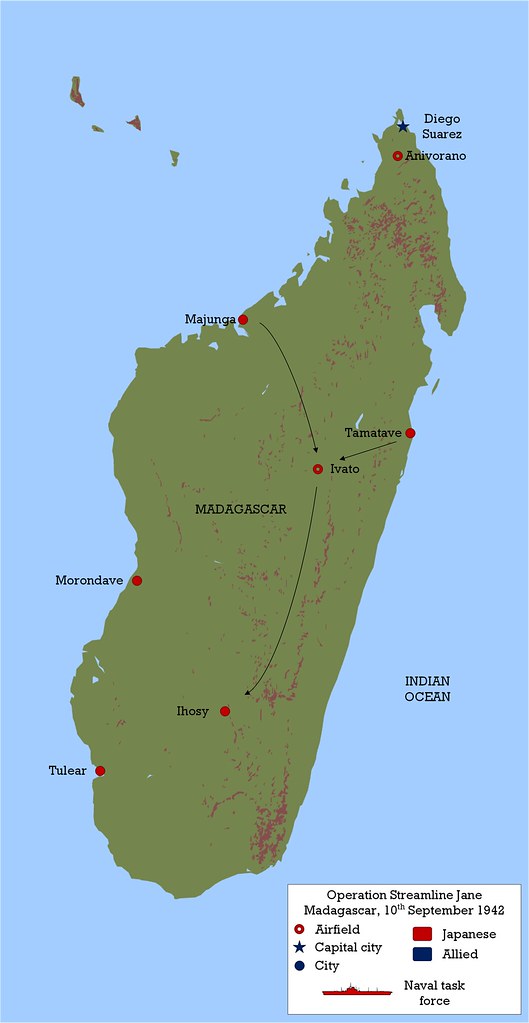
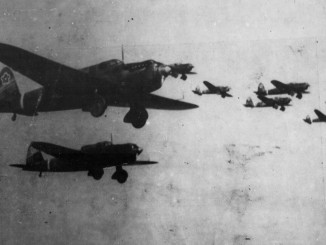
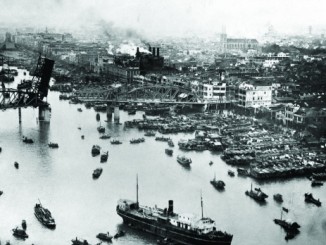
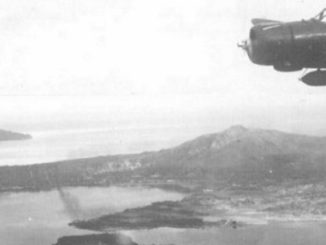
Leave a Reply